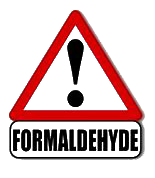Formaldehyde Use
in Labs
 During 2017, Environmental Health and Safety conducted evaluations of laboratories on the IUPUI campus using formaldehyde. The evaluations were based on a questionnaire focused on labs that had formaldehyde in their inventory as of mid 2016. Labs that reported using formaldehyde outside of a chemical fume hood or in quantities larger than 15 ml at a time were asked to participate in a follow-up evaluation.
The goal of the evaluations was to determine the potential need for exposure monitoring. The Occupational Safety and Health Administration (OSHA) has written a Formaldehyde Standard (29 CFR 1910.1048) which applies to all occupational exposures to formaldehyde, i.e. from formaldehyde gas, its solutions, and materials that release formaldehyde. OSHA has set an Exposure Threshold of 0.1 ppm; the level at which IU requires annual formaldehyde training. OSHA has also set an Action Level of 0.5 ppm, a Permissible Exposure Limit of 0.75 ppm, and a Short Term Exposure Limit of 2.0 ppm. The evaluations resulted in a number of positive findings as well as areas of improvement.
Positives:
- The use of chemical fume hoods when working with formaldehyde, including 37% formaldehyde and paraformaldehyde, was found to be appropriate in all labs.
- Lab coat and glove usage was found to be appropriate in all labs.
- There were zero labs identified from the follow-ups that require an exposure assessment be conducted, other than those labs already included in the formaldehyde monitoring program.
Areas of Improvement:
- The use of safety glasses can be improved in splash potential situations such as placing tissue into solution cups.
- All employees working with formaldehyde are required to take the Formaldehyde Hazard Communication training.
- Paraformaldehyde is an exposure concern when heated to create formaldehyde in a solution.
We would like to thank everyone who completed the questionnaire and all of the labs that took the time to meet with our team for the follow-up evaluations. If you or anyone in your lab is in need of the Formaldehyde Hazard Communication training, please click here. |